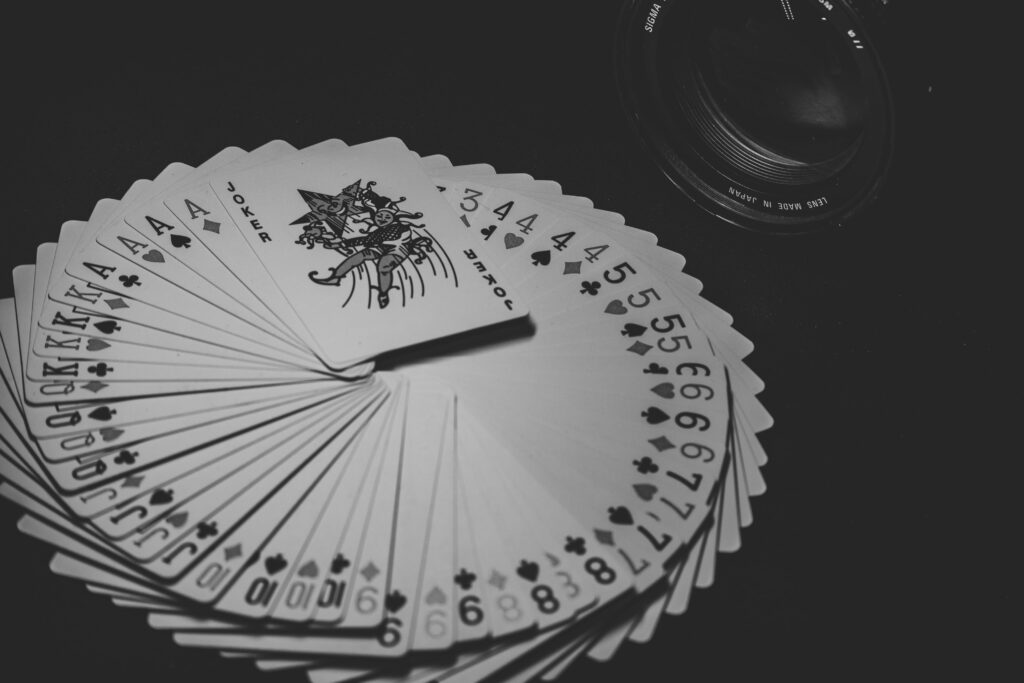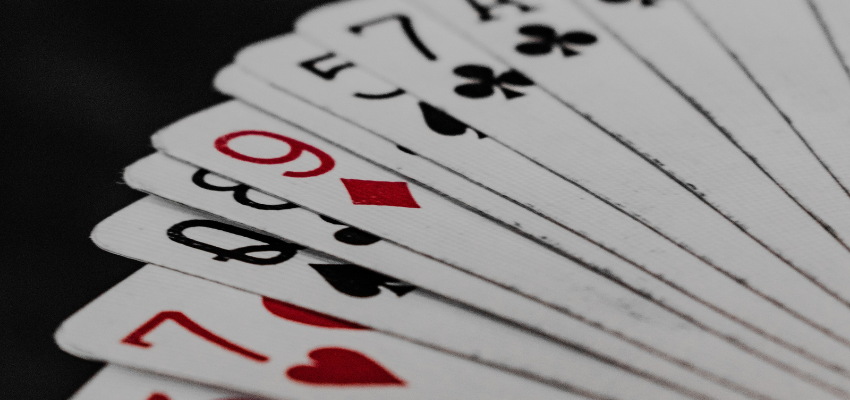I love talking about information. We all use it. We all need it. Without intending to sound too cliché, information is the building blocks of all things.
I also love games. I love talking about games, I love playing games, and I absolutely love talking about what games can represent.
Bridging the theme of games, research, and information literacy isn’t always easy. Playing cards lend themselves to an interesting exploration of information and knowledge.
Playing cards as information
What is information?
A signal or character (as in a communication system or computer) representing data
Merriam-Webster Dictionary

What makes a deck of playing cards “information”?
Is it the symbols on the card that make this deck information? How about the numbers? Are the face cards information?
Consider a modern deck of playing cards. Each deck contains the following cards:
♠ A 2 3 4 5 6 7 8 9 10 J Q K
♣ A 2 3 4 5 6 7 8 9 10 J Q K
♥ A 2 3 4 5 6 7 8 9 10 J Q K
♦ A 2 3 4 5 6 7 8 9 10 J Q K
We are familiar with playing cards so we know what the information above means. Let’s break down what information we have in the deck of cards.
- Each deck has two colours of cards (red and black).
- Each deck also contains four suits (spades, clubs, hearts, and diamonds).
- Within each suit, 13 cards (nine numbered cards, an ace, and three face cards Jack, Queen, and King).
On their own, these cards are simply information and data. Without context or instructions, these cards are essentially useless to us.
However, if I were to tell you we are playing Poker and you understood the rules, you can start to turn that information into knowledge.
Playing cards as knowledge
What is knowledge?
The fact or condition of knowing something with familiarity gained through experience or association OR the range of one’s information or understanding
Merriam-Webster Dictionary

How do we transform the information into knowledge?
If you were playing poker and were dealt the following hand (♠ A ♣ A ♥ A ♦ A ♥K) there is a good chance that you would know you have a pretty good hand and chances are pretty good that you would beat everyone you are playing against.
Similarly, if you were dealt the following hand (♠ 2 ♣ 3 ♥ 5 ♦ 7 ♠ 8) you would be sitting on a pretty miserable hand.
We are able to take the data/information on the cards and create meaning and knowledge. As users of the cards, we need to know the rules to transform that information on the cards into usable knowledge. That knowledge helps us to make informed decisions.
Fun bit of information, there are a whopping 2,598,960 combinations of hands in standard poker.
When we start to interpret the information we can create meaning. Cards are interesting. We use them as a canvas to play many games such as: Go Fish, Poker, Euchre, Hearts, Rummy, Solitaire, Cribbage, 21, and Speed, just to name a few. The information on the cards remains the same, however, our need to interpret and use that information changes.
What about the decks themselves?
So we talked about the information on the cards, but what about the physical deck itself?

To me, this is what makes information interesting. The cards themselves are artifacts and therefore information.
If humanity were to disappear from the face of the Earth and aliens from another planet visited Earth tomorrow, would the physical manifestation of the deck not be information? From the physical deck of cards, we can start to establish a cultural understanding of people. It’s a game, it tells us about the social aspects of humanity.
Cultural history through decks of cards
We can also learn about history through playing cards. Consider the evolution of the cards themselves. I encourage you to have a look at this article about the evolution of playing cards as they made their way from the East into Europe into North America (history of playing cards).
Consider a few of the evolutions of playing cards from the above blog post:
Germans introduced their own suits to replace the Italian ones, and these new suits reflected their interest in rural life: acorns, leaves, hearts, and bells; the latter being hawk-bells and a reference to the popular rural pursuit of falconry. The queen was also eliminated from the Italian courts, and these instead consisted of a King and two knaves, an obermann (upper) and untermann (under).
Meanwhile early in the 15th century, the French developed the icons for the four suits that we commonly use today, namely hearts, spades, diamonds, and clubs, although they were called coeurs, piques, carreaux, and trefles respectively. It is possible that the clubs (trefles) derive from the acorns and the spades (pikes) from the leaves of the German playing cards, but they may also have been developed independently. The French also preferred a king, queen, and knave as their court cards.
But the real stroke of genius that the French came up with was to divide the four suits into two red and two black, with simplified and clearer symbols.
(History of playing cards).
Although it might oversimplify the concept. Playing cards themselves hold information as an artifact of human development.
Conclusion
Games can be used as excellent metaphors for life. I’m not a card shark, but cards can be excellent tools to explain information and knowledge. I’m always looking for metaphors and stories to explain advanced concepts. Playing cards present a unique experience for teaching.
Header Photo by Klim Musalimov on Unsplash

